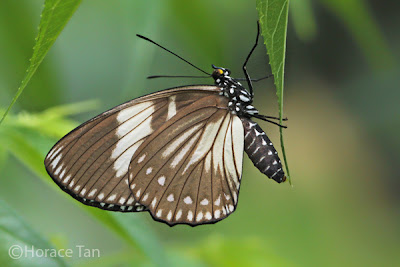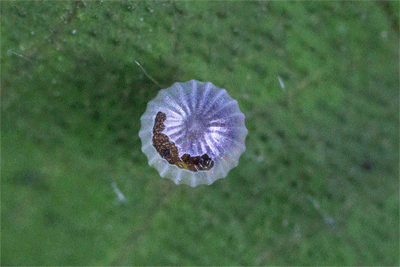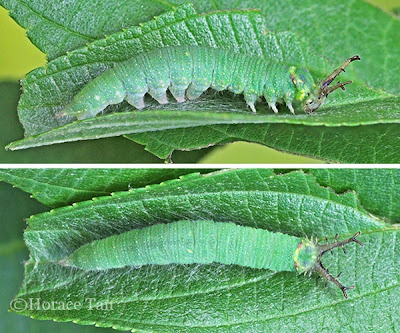Butterfly Biodata:
Genus: Euripus Doubleday, 1848
Species: nyctelius Doubleday, 1845
Subspecies: euploeoides C & R Felder,1867
Wingspan of Adult Butterfly: 50-70mm
Caterpillar Local Host Plants: Trema tomentosa (Ulmaceae, common name: Rough Trema, Poison Peach), Trema cannabina (Ulmaceae, common name: Lesser Trema).
A male Courtesan perching on a branch of a Trema plant.
A male Courtesan resting at a leaf perch.
A sunbathing male Courtesan giving a view of its upperside.
Physical Description of Adult Butterfly:
The eyes of both sexes are yellow but those of the female are darker with varying degrees of brown shading. The male has the termen of its hindwing indented between veins 2 and 4, and between veins 5 and 6. Above,
the male is bluish black with its forewing endowed with a complex series of white spots/patches in the cell, discal and post-discal areas. The hindwing is predominantly white with blackened veins, marginal and submarginal series of small white spots. Of the two female forms (-isina, -euploeoides) present in Singapore, form -isina (a mimic of the male Magpie Crow (Euploea radmanthus)) has its wings bluish black with a large post-cellular white patch on the forewing and a broad white area in the inner basal half of the hindwing. Faint marginal series of whitish spots are present in both wings while a post-discal series of faint white spots is present in the hindwing. Form -euploeoides (a mimic of the female Magpie Crow) has its wings brown in colour. In the forewing, the post-cellular white patch is rather broad and an additional white patch is present in the cell. In the hindwing, the whitish area occupies almost two-thirds of the wing. The marginal, submarginal and post-discal series of white spots are larger and more distinct than those found in form -isina. Underneath, the wings are brown for both sexes with similar white markings as per the upperside.
A female form -isina Courtesan on a leaf perch.
The upperside view of a female form -isina Courtesan.
Another female form -isina Courtesan.
Field Observations of Butterfly Behaviour:
Courtesan is rare in Singapore. The adults have been found in various parts of nature reserves, as well as Southern Ridges and even the Singapore Botanic Gardens. They are typically found in an area where its host plants are thriving. The male has a strong flap-glide flight pattern while the female mimics the slow and unhurried flight pattern of its model.
A female form -euploeoides Courtesan taking nectar from flowers of mile-a-minute.
The upperside view of a female form -euploeoides Courtesan.
A female form -euploeoides Courtesan on a leaf perch.
Early Stages:
The two local host plants recorded are Trema species which has a widespread distribution in Singapore. The caterpillars of the Courtesan feed on leaves of the host plants.
Local host plant #1: Trema tomentosa.
Local host plant #2: Trema cannabina.
The eggs of the Courtesan are laid singly on the leaf of the host plant, typically on the upperside of the leaf. Each pale yellowish green egg is globular with a diameter of about 1.2mm. A number of longitudinal ridges are present.
A female form -euploeoides Courtesan laying an egg on a leaf of the Lesser Trema.
A female form -isina Courtesan laying an egg on a leaf of Lesser Trema.
A branch of the Lesser Trema with an egg laid on the upper surface of a leaf.
Two views of an egg of the Courtesan.
Each egg takes about 3-3.5 days to hatch. The young caterpillar nibbles away the egg shell in a manner akin to the act of opening a tin can with the polar part of the egg shell uneaten and resembling the lid of a tin can as the caterpillar emerges.
Two views of a maturing egg of the Courtesan.
An animated sequence showing the caterpillar nibbling away a strip of egg shell in an anticlockwise direction, prior to its emergence.
A newly hatched Courtesan caterpillar eating its egg shell.
The newly hatched is pale yellowish with a a body length of about 3.5mm. The head capsule is black. The body surface has numerous small whitish tubercles and numerous tiny whitish setae. There are two backward-pointing white anal processes.
Two views of a newly hatched caterpillar, length: 3.5mm.
Two views of a 1st instar caterpillar, length: 5mm.
As the 1st
instar caterpillar grows up to a length of about 6.5-7mm, the body takes on a strong green undertone. After about 3-3.5 days in the 1st instar, the caterpillar
moults to the next instar.
Two views of a late 1st instar caterpillar, dormant prior to its moult, length: 6.5mm.
The 2nd instar caterpillar has a few changes in its appearance as compared to the 1st instar
caterpillar. Now the body ground colour is green. The head capsule is black with two large cephalic horns, featuring side branches on the lateral peripherals as well as on the cephalic horns. Each cephalic horn is forked at the tip. The numerous tubercles and the anal processes are now yellowish in colour. Three pairs of small doro-lateral circular spots on the 2nd, 4th and 7th abdominal segments might occur in some specimens. This instar lasts about 3 days with the body length reaching up to 9.5mm-10mm before the next moult.
Two views of a 2nd instar caterpillar, newly moulted, the head capsule yet to turn black.
Two views of a 2nd instar caterpillar, length: 7.5mm.
Two views of a 2nd instar caterpillar, dormant prior to its moult, length: 9.5mm.
The 3rd instar caterpillar resembles the 2nd instar caterpillar closely. The main change occurs in the head capsule where the cephalic horns are proportionately longer, and there are white patches on both sides of the head. The rear-facing side of the cephalic horns has changed from black to brown/dark brown. The occurrence of the three pairs of dorso-lateral spots on the 2nd, 4th and 7th abdominal segments is not consistent across individuals with some having only a subset or even none at all. This is true even for the next two instars. The 3rd instar takes about 3 days to complete with the body length reaching up to 15.5mm.
Two views of a 3rd instar caterpillar, early in this stage, length: 10.5mm.
Two views of a 3rd instar caterpillar, length: 11mm.
Two views of a 3rd instar caterpillar, late in this stage, length: 15mm.
Two views of a 3rd instar caterpillar, dormant prior to its moult, length: 15mm.
The 4th instar caterpillar resembles the 3rd instar caterpillar closely with the main change occurring again in the head capsule. Now the "face" is greenish to bluish with white lateral stripes, and the rear facing side of the cephalic horns is pale yellowish greenish to pinky brown. In each cephalic horn, the fork at the tip and the side branches are smaller than in the earlier instar with their front-facing side coloured in black. The body appears to be predominantly green as the numerous yellow tubercles covering the body surface are now miniscule and much less distinct. The three pairs of dorso-lateral spots, if present, are now much larger and prominent in contrast. Another pair of similar looking subspiracular spots could also occur on the 3rd abdominal segment. Typically these spots are reddish brown for most part of the instar and only turning yellowish on the last day of the instar. This penultimate instar lasts about 4 days with body length reaching about 25-27mm.
Two views of a 4th instar caterpillar, early in this stage, length: 15mm.
Two views of a 4th instar caterpillar, late in this stage, length: 27mm.
Two views of a late L4 caterpillar, dormant prior to its moult, length: 24mm.
The next moult brings the caterpillar to its 5th and final instar. Now the head capsule is mostly bluish green with the proportionately longer cephalic horns having small spatula-like forks at its tip. The rear-facing side of each horn is mostly green but pinky brown near the base. The two short and pointed anal processes are now green in colour.
Two views of a newly moulted 5th instar caterpillar .
Two views of a 5th instar caterpillar, length: 32mm.
Two views of a 5th instar caterpillar, with all three pairs of dorso-lateral spots present, length: 36mm.
Two views of a 5th instar caterpillar, late in this stage, with dorso-lateral and subspiracular spots turned yellow, length: 35mm.
The 5th instar lasts for about 5-7 days, and the body length reaches up to 36-40mm. As in the 4th instar, the dorso-lateral spots which are initially reddish brown would turn yellow on the last day of this instar.
Two views of a 5th instar caterpillar, with only one pair of dorso-lateral spots present, length: 39mm.
Two views of a 5th instar caterpillar, with only one pair of dorso-lateral spots present, turned yellow, length: 38mm
Toward the end of the 5th instar, the body gradually shortens in length with the body base colour turning to translucent green. Eventually the caterpillar comes to rest on the mid-rib on the underside of a leaf or the underside of a branch of the host plant. Here it stays dormant for a while before spinning a silk pad and anchoring its anal claspers to it. It then becomes an pre-pupatory larva in this upside-down pose.
A pre-pupatory larva of the Courtesan.
Pupation takes place about 0.5-1 day later. The pupa suspends itself with a cremastral attachment to the silk pad on the substrate. The pupa is mainly green mottled with cryptic white markings. Each pupa has a pair of short cephalic horns. The body has a keeled appearance as it broadens and tapers to a sharp ridge on the dorsum of the entire abdomen. Length of pupae: 27.5-29.5mm.
Two views of a pupa of the Courtesan.
After 5-6 days of development, the pupa turns black as the development within the pupal case comes to an end. Whitish patches/spots on the forewing are now visible on the wing pad through the pupal skin. The next day the adult butterfly emerges from the pupal case.
Two views of a mature pupa of the Courtesan.
A newly eclosed male Courtesan resting near its pupal case.
A newly eclosed male Courtesan.
References:
- [C&P4] The Butterflies of The Malay Peninsula, A.S. Corbet and H.M. Pendlebury, 4th Edition, Malayan Nature Society.
- Butterflies of Thailand, Pisuth Ek-Amnuay, 2nd Edition, 2012
- A Field Guide to the Butterflies of Singapore, Khew S.K., Ink On Paper Communications, 2010.











1.jpg)










1.jpg)


1.jpg)

















No comments:
Post a Comment